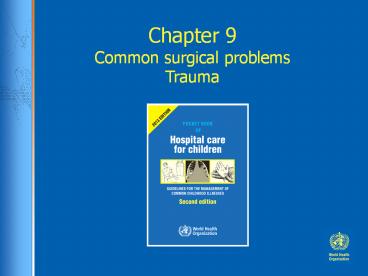Chapter 9 Common surgical problems Trauma - PowerPoint PPT Presentation
Title:
Chapter 9 Common surgical problems Trauma
Description:
Chapter 9 Common surgical problems Trauma Case study: Hamid 14 year old boy was involved in the accident with a car Brief History of Accident Passenger on the back of ... – PowerPoint PPT presentation
Number of Views:138
Avg rating:3.0/5.0
Title: Chapter 9 Common surgical problems Trauma
1
Chapter 9Common surgical problemsTrauma
2
Case study Hamid
14 year old boy was involved in the accident with
a car
3
Brief History of Accident
Passenger on the back of the motorcycle. Hit by a
car, slid along the road for some distance before
hitting a post on the side of the road. There was
brief loss of consciousness. Wearing a helmet. He
was placed in the back of another motor vehicle
and driven to the hospital. On arrival he was
alert but in severe distress. Complaining of pain
in the chest and left thigh.
4
Stages in the management of a sick child (Ref.
Chart 1, p. xxii)
- Triage
- Emergency treatment
- History and examination
- Laboratory investigations, if required
- Main diagnosis and other diagnoses
- Treatment
- Supportive care
- Monitoring
- Discharge planning
- Follow-up
5
What emergency and priority signs have you
noticed?
- In Trauma this is called thePrimary Survey
- Brief history
- Assessment of ABC
- A no stridor or obstruction
- B RR 50/min with intercostal recession and no
right sided chest movement, SpO2 88, cyanosed - C BP 85 systolic, HR 148, capillary refill 4
seconds, cold limbs
6
Triage
- Emergency signs (Ref. p. 2)
- Obstructed breathing
- Severe respiratory distress
- Central cyanosis
- Signs of shock
- Coma
- Convulsions
- Signs Severe dehydration
7
Triage
- Emergency signs (Ref. p. 2)
- Obstructed breathing
- Severe respiratory distress
- Central cyanosis
- Signs of shock
- Coma
- Convulsions
- Signs Severe dehydration
8
What emergency treatment does Hamid need?
9
Emergency treatment
- Treat problems with ABC
- Airway OK, c-spine stabilisation
- B Oxygen
- Needle thoracostomy R chest for urgent
decompression (Ref p. 349) - C Intravenous line and bolus fluid 20ml/kg
Hartmanns or 0.9 NaCl - Then do initial x-rays (chest, lateral c-spine,
pelvis)
10
Chest x-ray
11
Emergency treatment (continued)
- B x-ray confirms tension pnerumothorax
- Insert intercostal catheter (Ref p.349)
- C Stop any external bleeding
- Reassess child after appropriate IV fluid has run
- Measure the pulse and breathing rate at start and
every 5-10 minutes
12
Further history
Hamid was the passenger on the back of the
motorcycle, driven by his father. The estimated
speed of the bike was 50 km/h. A car hit the bike
on the left side, and Hamid slid along the road
before hitting a post on the side of the road. He
was wearing a helmet, but only shorts and a
t-shirt. There was brief loss of consciousness,
but he could talk to his father until help
arrived. He was placed in the back of another
motor vehicle and driven to the hospital. On the
way to the hospital he started to have difficulty
breathing. On arrival he was alert but
distressed. He was complaining of pain in the
chest and left thigh.
13
Examination Secondary Survey (head to toe
examination)
First Reassess vital signs after Emergency
Treatment A airway OK B RR 40/min, right chest
good air entry, SpO2 95 C BP 105 systolic,
capillary refill 2 seconds, pulse volume good,
heart sounds audible, no apex beat
displacement Cervical spine not tender, no
swelling, moving limbs Abdomen soft and non
tender, no distension Rolled with spinal
precautions Back abrasions Limbs externally
rotated left leg, swollen thigh,foot pulses
present
14
Investigations
- Chest x-ray repeat after chest drain
- Cervical spine x-ray - normal
- Pelvis x-ray - normal
- Left femur x-ray ?
- Haemoglobin, cross-match
15
Femur
16
Treatment
- ? Fractured distal femur
- ? Stabilise then refer to a surgeon (Ref. p. 275-
279) - ? Abrasions
- ? Clean the skin and avoid an infection
- ? Possible abdominal trauma
- Observe the child and look for signs of
peritonitis, review by surgeon - (Ref. p. 275)
17
What supportive care and monitoring are required?
18
Supportive care
- Pain control (Ref. p. 275)
- In-dwelling urinary catheter
- Blood transfusion not necessary as shock resolved
with IV fluid and drainage of the tension
pneumothorax, and haemoglobin 9g/dl (Ref. p. 276) - Nutrition when abdominal injury is excluded and
Hamid is stable (Ref. p. 271-273)
19
Monitoring
- Frequent observations of
- Pulse, signs of respiratory distress, SpO2
- Chest tube water level swinging, follow-up chest
x-ray, decision on timing of removal - Check sensation, motor power, pulses and
capillary return in left leg and foot - Abdominal tenderness
20
Follow-up
- Review of fracture healing
- Physiotherapy
- - and give simple suggestions to the mother for
passive exercises
21
Summary
- Hamid is a 14 year old boy who was involved in a
multi-trauma. He sustained a tension
pneumothorax, fractured femur and abrasions. He
had mild concussion only. - Primary Survey (brief history ABC) ? Emergency
treatment, Secondary survey ? injury treatment,
monitoring, supportive care, discharge planning
follow-up































